Chapter Twenty-One
Sadhana Years in America
In March of 1950, Sri Subramuniya founded Muruga Ashram in Santa Cruz, California. He was eager to bring the Hindu Deities to the West. Advised by his guru to wait until he was thirty to begin his mission, Sri Subramuniya spent the following seven years in contemplation and inner pursuits, allowing his ordination and realization to mature.§
I followed Yogaswami’s instructions and returned to the United States and settled down to unfolding more and more. Until his death, he communicated with me, year after year, through Kandiah Chettiar. Upon returning to the US, the first thing I did was to change my name legally to my new Saivite Hindu name [Subramuniya]. The judge took it in stride and quickly granted the request. Right after my ordination with Yogaswami, the book Cognizantability began to unfold from within me.§
Little more is known of these years of contemplation, which were outwardly uneventful for the most part. Returning to Oakland, he connected again with Mother Christney and in April began composing the first of the affirmations that would later be published as Cognizantability. §
He returned for at least two years to the world of dance, touring with New York’s Metropolitan Opera in their production of “Die Fledermaus,” which opened in Boston then traveled through the East Coast and into Canada. While with the Met, he made his first radio and television appearances, performing bit parts, and became a member of the Screen Actor’s Guild and the American Guild of Variety Artists. He would speak of his months of travel, living out of a suitcase, spending days on long train rides through the countryside. Training, practicing, performing, and earning $1,000 a month. He quit when the tour went to South America.§
There followed what he termed “years of sadhana and solitude,” spent mostly in the Southwest: New Mexico and Arizona. He supported himself teaching Indian and Western dance, hatha yoga and Hindu advaita philosophy; but his real work was the spiritual work, and he cherished his aloneness.§
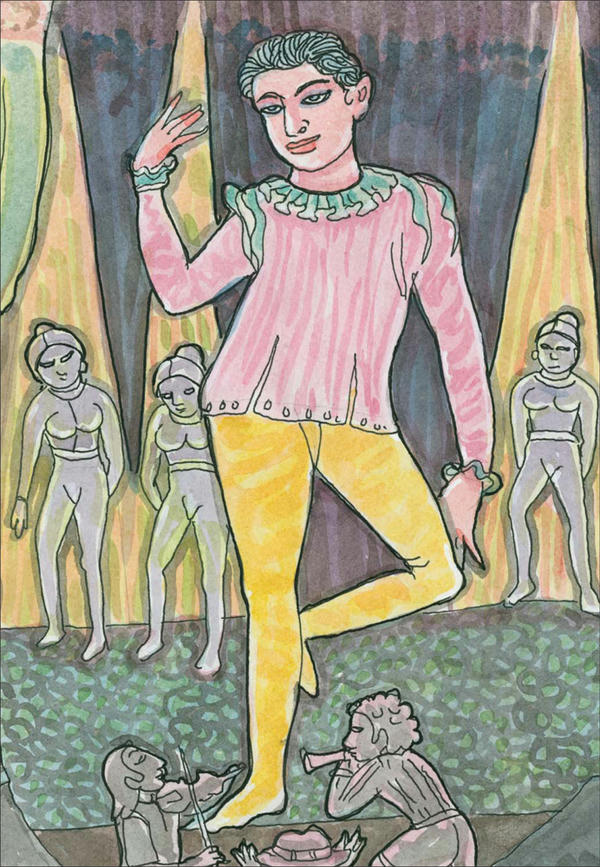
For two years following his return from Ceylon, Sri Subramuniya returned to the stage to earn his keep. Though he toured the US and Canada with the New York Metropolitan Opera company, his heart was more interested in solitude and sadhana.
• • • • • • • • • • • • • • • • • • • • • • • •§
In 1956 he migrated north into the pure mountains of Colorado that are today the refuge of seekers and modern-day mendicants. His meditations deepened there. In Denver he underwent a tremendous spiritual experience during deep contemplation, as the last of the outer self was displaced by the matured soul. He would later describe this event as “the full actualization of the svarnasharira in which the soul body displaces the outer self.” At that time, the golden body of the soul completely inhabited the physical body, concluding the long climb up the spine to its permanent home in the crown chakra and the descent of the divine into the body. He later wrote:§
The golden body, svarnasharira, is a body made of golden light. After many experiences of Parasiva, it gradually descends from the seven chakras above the sahasrara into the ajna chakra, which then becomes the soul’s muladhara, then down into the vishuddha chakra, which then becomes its muladhara, and then down into the anahata, which then becomes its muladhara. §
All seven chakras above the sahasrara slowly come down and down and down until the entire astral body is psychically seen, by mystics who have this sight, as a golden body. The astral body slowly, slowly, slowly dissolves into the golden body. That is what I have seen happen. That is what our parampara and our sampradaya know from experience. Experience is the only true knowing—a knowing that can be verified in books, through others who have the same knowing, but a knowing that no others know who have not had the same experience. To them it is only a concept, a nice one maybe, but just a concept or written off as an opinion. §
When the golden body fully enters the physical, having taken over the astral, the knowing that is known comes unbidden. It is beyond reason but does not conflict with it. It is a living scripture but does not conflict with those written by seers of the past who have seen and their records have become scripture. So great is the Sanatana Dharma that it defies all who doubt it, all who disdain it, all who disregard it, all who degrade it, with personal realization of its Truth. §
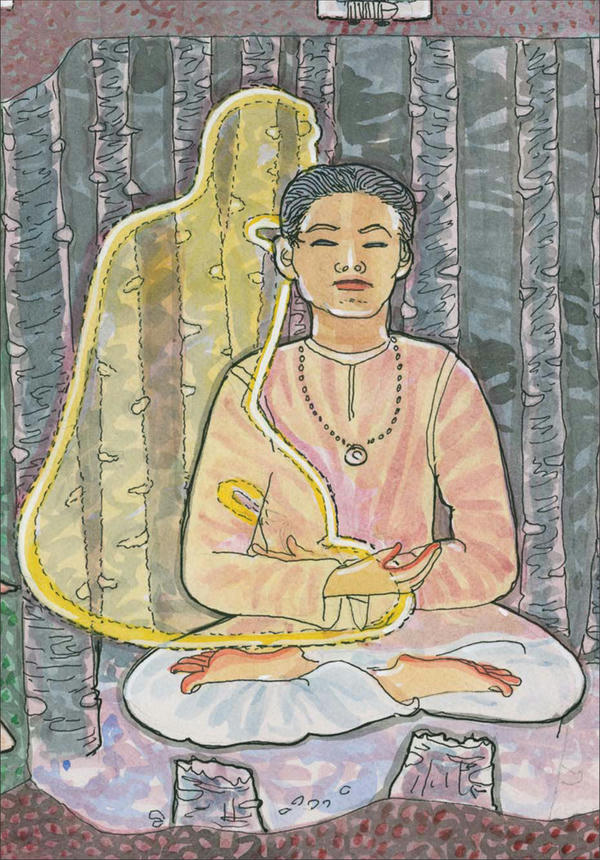
In Denver in 1956 Subramuniya underwent a life-transforming spiritual experience during which his golden soul body displaced his outer self. Soon thereafter Yogaswami, thousands of miles away, announced, “Hansen is dead.”
• • • • • • • • • • • • • • • • • • • • • • • •§
This golden body, which begins to build into a golden body after the experience of nirvikalpa samadhi, is connected to the sahasrara chakra. In other words, the sahasrara chakra is the home base in the physical body for the golden body. There are twelve basic unfoldments to this chakra as the golden body grows. When the realized sannyasin travels in high states of contemplation, he moves freely in his golden body and can help and serve mankind. Over time, he gains a conscious control of the sahasrara chakra as a force center which propels him into inner space. §
It is this golden body, as it refines and refines and refines itself within the Sivaloka after moksha, that finally merges with Siva like a cup of water being poured into the ocean. That same water can never be found and put back into the cup. This truly is svarnasharira vishvagrasa, the final, final, final merging with Siva. §
Two Superconscious Encounters
After the Denver experience, Satguru Yogaswami began telling people in Jaffna, “Hansen is dead.’’ They thought it so until he wrote to Kandiah Chettiar from America a few months later to say that his mission had begun. Then the Jaffna Tamils understood that it was only his outer self that had died. Sri Subramuniya was alive and busy fulfilling the mission foreseen by Yogaswami. §
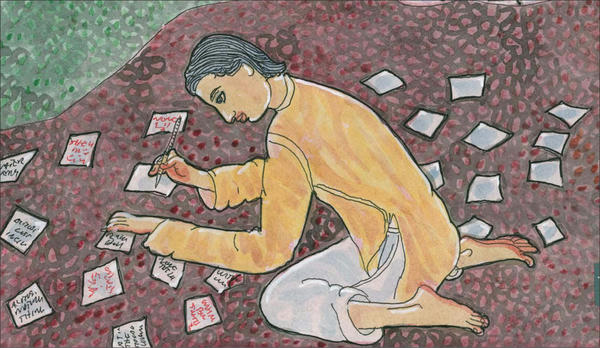
One day in the late 1950s, Subramuniya experienced the reality of the subsuperconscious mind: taking dozens of pieces of paper on which he had written mystical aphorisms, he wrote a commentary on the blank side of each that corresponded perfectly.
• • • • • • • • • • • • • • • • • • • • • • • •§
It was in Denver, the mile-high city in the Rocky Mountains, that the commentaries [to Cognizantability] were written, seven years after the aphorisms were revealed. My external mind was learning to fully accept superconscious knowing, and the deeper inner mind was actively making itself the knower of the known. §
Oddly enough, one day the inner said to the outer mind to number each aphorism, which are now Sections One and Two of Cognizantability, and place them all face down on the floor. I obediently did this. Then, one after another, the commentaries were revealed, three words at a time with a significant pause between. The superconscious would dictate word by word to the conscious mind to be written down. Amazingly, it proceeded to dictate the commentary to number seven, then number fourteen, and so on. When all were done, the natural impulse urged me to turn over the aphorisms that were still face down on the floor with a number on the back to see if the commentary matched the aphorism. It did! They all did! Truly, I became a more dedicated believer in the jnana marga, the aftermath of experiencing the beyond of the beyond of the beyond, which we call Parasiva, the fulfillment of the yoga marga. §
As the years passed by, one after another, this procedure of bringing unrehearsed wisdom through from the higher mind to the external became a natural part of my daily life, “one of the tools of the trade,’’ I have often said. These psychic powers sometimes take years to develop. But under the right circumstances those carried over from a previous incarnation come immediately, of course, and are as much available as the ability to speak, listen and feel.§
One of Sri Subramuniya’s avid pursuits was the study of religious organizations—to determine the most stable and workable vehicle for Saivite Hinduism in Western culture and a technological age. He finally settled on the American church system. §
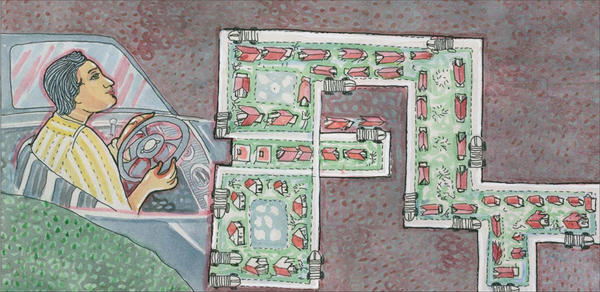
Driving one day in Phoenix, Subramuniya had an encounter with his inner voice. It instructed him to follow a convoluted route through a sprawling suburb, which he obediently did, only to be led, after two hours, right back to the beginning.
• • • • • • • • • • • • • • • • • • • • • • • •§
I was told by Yogaswami, “Don’t really start to do anything until you are thirty years of age. You have to be more mature.” Until then I was to observe, have experiences and learn. So, I was sort of biding my time until I was thirty years of age. I went to Phoenix, Arizona, knowing that I would eventually get an organization going. Naturally, I wanted to know how to do that! So, I went around to all the other organizations—Vedanta Society, the Rosicrucian Order, Paramahansa Yogananda’s organization—and I analyzed all their problems. You know you don’t have to look at the successes, because you are successful if you don’t have problems, automatically. I analyzed all their problems and all their faults and failings.§
As I traveled through the United States from the age of 23 to 30, observing the various schools, philosophies and techniques given to aid people in philosophical and metaphysical thinking, I found that there was more philosophy and metaphysics than actual instructions on how to put it into action in your own life for spiritual awakening. The desire to fulfill that need directly began to grow and grow in me. I saw that the Western man needed a comprehensive, step-by-step, well-supervised method of study. This he was not getting. Those who did give a step-by-step training in metaphysics divided God and man and practiced techniques to put the pieces together again. This philosophical division led man more to an unsettled frustration than to bringing forth his inner security. Fine teachers from the East came and taught, but didn’t remain long enough for a continued, positive, direct supervision of the individual’s unfoldment, either on an individual basis or organizationally.§
Finally, the time came to begin teaching, and I thought I would open the organization in Phoenix. So I went to the registrar of organizations and said, “I would like to open this organization. What shall I do?” He said, “The thing to do is to go to a sign maker and get a sign.” I said, “Any papers to fill out or anything?” He said, “No, this state welcomes spiritual activity. Just go get a sign.”§
While I was waiting and deciding, I had another experience one day while driving my small car. My inner self told my outer self, “Look at that sign.” If any of you have been to Phoenix, you know it’s totally a flat area, absolutely flat. There I was, driving around this big flat area where there were lots of houses and homes. “Look at that sign. Remember the sign.” It was Spruce Street. I took note of the sign. Then I said, “Okay, I’m just going to get into my inner self.” Inner self said, “Drive twenty blocks forward, turn left and drive ten blocks, turn right and drive five blocks, turn left, two blocks, turn around, back up, go ten blocks,” and on and on like that for about two hours as I followed the instructions. Then it said, “Stop and look at the sign!” Spruce Street! I was a believer in myself, an absolute believer in myself.§
After that I went to San Francisco and started the organization there. I had given a little talk and there were some people that were really interested. So I thought: “Well, how do I get it going? You need a lawyer.” Because California was different. You had to have papers and everything, tax exemptions, and this and that. So where am I going to find a lawyer? I said, “I know.” I went to the FBI. I knocked on the door and I said, “I’m getting this organization going. Can you direct me to an attorney?” They referred me to the man who would be our attorney for several decades. He had me develop a file of my work for the FBI, saying then they would never worry about me.§
It was made quite clear to me that when I was thirty my students would start to come, so I waited. It happened just that way. This is how Himalayan Academy started in the United States in 1957. §
Settling in San Francisco
For a short time after leaving Phoenix, Sri Subramuniya taught yoga classes to students in Los Angeles, but soon he moved to San Francisco. He held the first Applied Yoga class in a small Bush Street apartment in downtown San Francisco. A few stories above the clatter of a noisy street, the first few eager students began the study of themselves and awakened a new world of inner awareness. §
He gave a talk at a small spiritualist church in the city to a group of elderly people, many of them women. In those days, yoga teachers were rare, and the subject was practically unknown. Theosophy was the fad of the day, and the healing work of Christian Science was in the ascendency. §
On January 5, 1957, the occasion of his jayanti, they asked him sincerely when he would begin to teach them. “Right now!’’ he replied. He explained he would work with them for a few months and see how they did. If all went well, if they practiced and benefitted, he would continue. §
The average age of that first group of students was fifty. For the most part, they were interested in psychism or spiritualism. Some had spirit guides and were interested in communication with the dead and other such phenomena. They were eager to know about healing with the mind, psychometry, alchemy and seeing auras. These areas, which he had been studying and experiencing his whole life, became the topics of many of his talks. He also spoke on the Cognizantability aphorisms, taught the basics of concentration and meditation, color psychology, breathing and the five states of mind, and gave instruction in hatha yoga and dance. His emphasis was always on Self Realization and the possibility of man’s awakening his own superconscious state of mind. Of course, the term superconscious was practically unheard of in those days. §
In April Sri Subramuniya gave his blessings for a permanent center. The Sutter Street Temple was opened that month, with Sri Arumugam, then Ceylon’s Minister of Agriculture, attending as the guest of honor. §
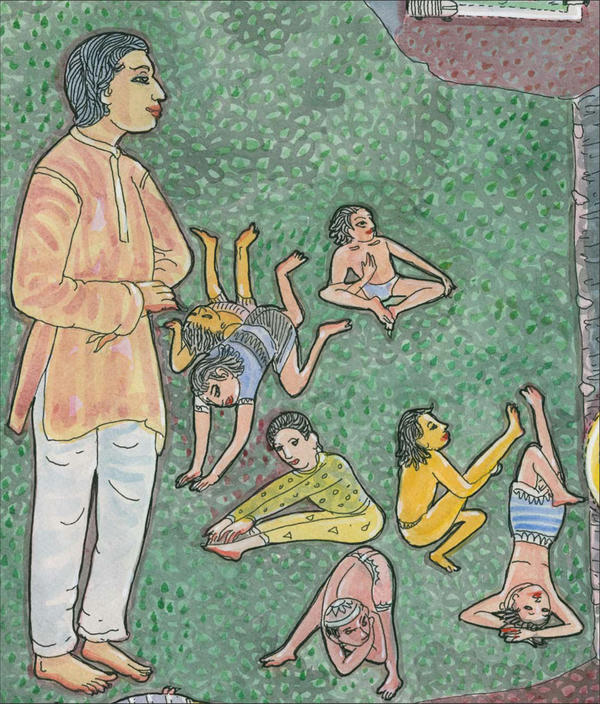
During the seven years of sadhana before his spiritual mission began, Subramuniya taught hatha yoga and dance to support himself.
• • • • • • • • • • • • • • • • • • • • • • • •§
As a guru, I started with the basic philosophy of all gurus, “To do nothing is the greatest thing on Earth,” simply responding to the needs of the students. I founded a temple, as it was needed at that time to harness the religious forces of those who were unfolding. The students were enthused and supported the temple. Later on, they asked for written materials, such as a course of weekly lessons of my inspired talks and teachings, neatly arranged for those who couldn’t attend the temple. I also responded to the needs of those who wished to be monastics and founded a monastic order. The monastics printed the lessons which today are The Master Course.§
During these formative years, Mother Christney brought her influence to bear. She dominated as a strong, elderly matron might, skewing the teachings toward her background, Christian spiritualism. As her long-time student, and her junior by 47 years, Sri Subramuniya supported her in this. He became the model of the spiritual leader she knew and idealized from her upbringing—preceptor, counselor, preacher, confessor. When she chose to name the institution the Christian Yoga Church, he understood her reasons. §
Knowing the innate power of the press and having a lifelong affinity for the newest gadget and techie tool, he bought a mimeograph machine, which was used for printing schedules, talks and programs as well as the first editions of his books Raja Yoga and Gems of Wisdom, the Church’s first publications. Sri Subramuniya learned to use the machine himself and then introduced it to his monks. §
Mimeograph was the office printing technology that preceded photocopiers. It was a paper stencil duplication device invented in the late nineteenth century and used through the 1980s. He would later tell his monks of cranking out tracts and pamphlets late into the night, hands stained with the bluish-purple dyes of a messy, smelly technology. It was the beginning of his lifetime of publishing, the first glimmerings of what would become a major part of his mission.§
The burgeoning group outgrew the Sutter Street building after two years and began looking for a larger place in the city for their chapel.§
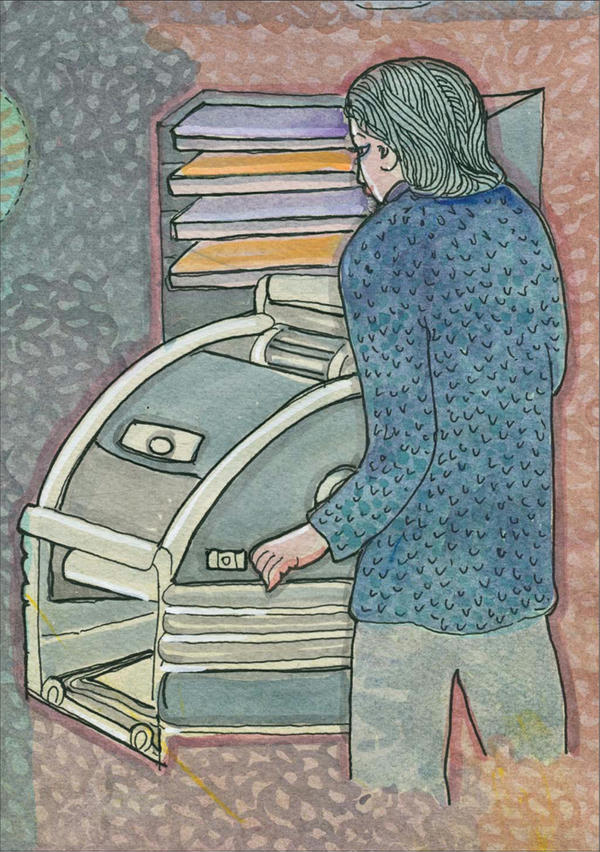
A consummate communicator, Sri Subramuniya was constantly recording, lecturing and printing. In the early days he ran a mimeograph machine himself—an early, and messy, printing technology.
• • • • • • • • • • • • • • • • • • • • • • • •§
Then an anonymous somebody put a thousand dollars in the little offering box—a lot of money in those days. I had rented a little place in which I had a vision of Siva dancing on my head. I heard the drums and everything. And I saw a big door in that same vision. As soon as I saw the door on the Sacramento Street Temple, I knew that was the place. It was to become the first Hindu temple in the United States.§
He used the $1,000 as a down payment on a building at 3575 Sacramento Street, a narrow, two-story apartment with a small garden in the back, not far from Park Presidio. The surrounding neighborhood, called Laurel Heights, was populated with apartments and small businesses, florists, restaurants and small stores. It had been used as a photography studio and was in unsound condition. To meet the city fire codes, the building had to be almost totally renovated. His students spent the next year or two in karma yoga on the building, several hours a day and late into the evenings after leaving their regular jobs. In the end, they had created the first public Hindu temple in America. On its opening day in 1959, the temple hosted the world-famous Kandyan Dance Troupe of Ceylon, then on tour in America. §
An altar was established in the main hall, and two massive doors, in the form of an archway, were made. One entered from the street through the giant doors, past two purple velvet curtains and into the small main chapel, complete with wooden pews, a rock altar and waterfall and pulpit made of a single stone. From this pulpit each Sunday morning Father Subramuniya, as he was then known, gave sermons on yoga, the states of mind and Hindu thought. He spoke of how to live well, how to awaken the inner light, how to overcome instinctive emotions and habits, and of spiritualism. §
Services were open to the public, though the upstairs was reserved for Father Subramuniya’s residence and the Church offices. The first floor garden rooms were used for personal counseling with devotees, a small kitchen, recording sessions and for group activities. §
When the congregation had settled in its new home, Sri Subramuniya put forth the first sacraments and initiations. He founded a yoga order and initiated the first monastics to serve the congregation. He stressed the importance of establishing a steady routine for mission activities in the years to come and stuck to that rule consistently, saying that would bring steady progress for everyone.§
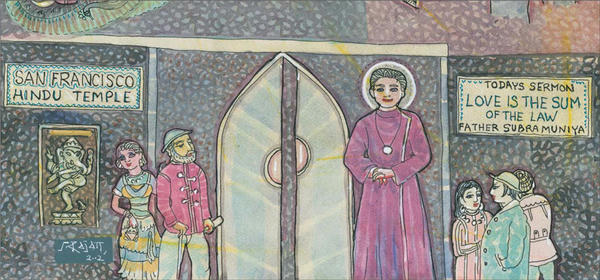
Sri Subramuniya founded the first Hindu temple in America near the Golden Gate Bridge in San Francisco. Here he taught of the advaita path to the Self.
• • • • • • • • • • • • • • • • • • • • • • • •§
To set the example himself, in the fall Sri Subramuniya commenced the first sunrise service on Mount Tamalpais, a 2,500-foot peak in Marin County that offers a view of the northern San Francisco Bay Area. He took a vow to hold this monthly pilgrimage until his organization was twelve years old, at which time it would be well established. §
On the first Sunday of each month, and on other auspicious occasions, his devotees met at the temple for a pre-dawn blessing and the lighting of 108 candles. Crossing the Golden Gate Bridge and driving part way up the mountain in a convoy of cars, Sri Subramuniya led the forty-minute hike to the summit for a sunrise sermon and meditation. He continued this monthly tirthayatra personally, rain or shine, for a dozen years, unless he was out of the country—a total of 154 pilgrimages in all. §
Every Sunday we would make a pilgrimage there. We had a big rock on the mountain that we used to think of as the Sivalingam. That was a very routine time. It was easy for me to be routined because of being a disciplined person from the early ballet dancing training. I ran the institution consistently. Something was happening all the time, and it kept repeating itself. §
Sunday morning, the big day of the week, found the half-dozen monks cleaning the temple and preparing for the 11am service. They would stock the shelves with books, incense and candles which congregants loved to buy and take home. The temple held about 50 people and was almost always full, with people standing and sitting in the hallways. Sunday service was also held at 8pm. Hymns were sung, mystical ones written by the monastics under Father’s guidance. §
He would enter the room through a door behind the altar, his tall frame and rich voice dominating the small room. He never spoke from notes. Not once. It was pure spontaneity, what he would call “from the inner sky.” There would be a topic, written dutifully on the sign outside the temple for all to see, but it was often a mere hint of what he would discourse on that day. §
Once he wrote the sermon’s title “Was Christ a Yogi?” It brought a larger than usual crowd, all wanting to know the answer. He began the sermon that day, “Our topic today is ‘Was Christ a Yogi?’ Yes, he was. Now, let me talk about the yoga that brings you into the inner light.” Not another word about Christ. §
In fact, much of what he taught had to be filtered through the vernacular of the mostly Christian community. Many of those who came to listen called themselves Christian yogis. The United States then was a thoroughly Christian country. Hinduism was little known and even less understood. Therefore, almost all of the early students and members had strong Christian backgrounds. They were a breed of mystical Christian, those who did not follow the my-path-is-the-only-path philosophy, but instead believed in a greater spiritual reality that was inclusive and tolerant. They found those values in the San Francisco temple. They were quite comfortable learning about the Hindu religion. §
In order to avoid confusion or opposition and to keep his Western devotees’ transition into the Hindu religion gradual and rewarding, Sri Subramuniya kept the teachings simple and unramified. §
The early years were a time of constant classes, lectures and counseling, for it was only through carefully educating the congregation that progress was made. There is a saying among the Buddhists of Sri Lanka: “The teaching not adapted to the needs of the taught cannot be called a teaching.” The wisdom of such an attitude was self-evident in the founding years. Despite his eagerness to present Saiva dharma exactly as he had absorbed it while a member of the orthodox Saiva community of Jaffna, Sri Subramuniya was forced to be patient, carefully presenting through the years the universal principles of Hinduism through the teachings of advaita and the science of yoga and encouraging his devotees always in the practice of bhakti.§
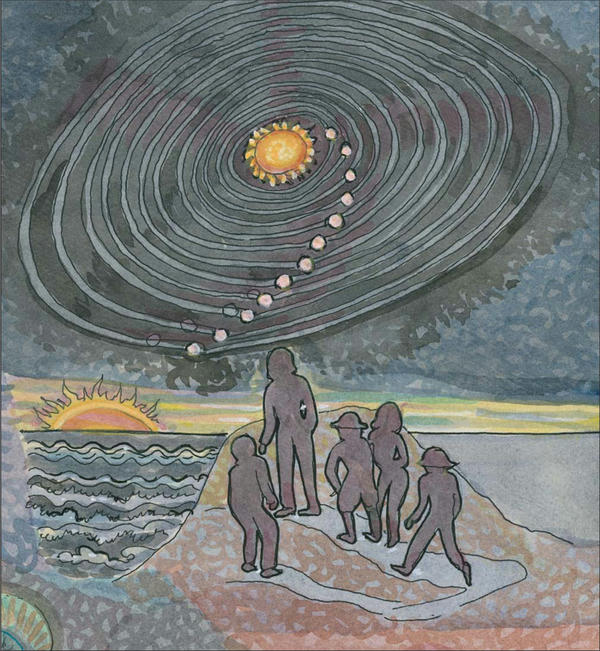
For twelve circles of the Earth around the Sun, Sri Subramuniya took devotees to the 2,500-foot summit of Mount Tamalpais. Arriving before dawn, they meditated among the redwoods and oaks, gaining what he called “a mountaintop consciousness.”
• • • • • • • • • • • • • • • • • • • • • • • •§
During these early years, I gave forth much of the teaching that’s in Merging with Siva: “Life the Great Experience,” “Love Is the Sum of the Law,” “The Power of Affirmation” and “The River of Life.” All those talks that some of you have heard for many, many, many, years started at that time. People started coming and going and going and coming. And I started seeing a new kind of life in the United States and adjusting myself to it. §
Sri Subramuniya had regular hours for personal counseling with members and participated in the many regular activities, always available to teach and answer questions. §
Gems of Wisdom, a book of his sayings, proved so popular that a second edition had to be printed in mid 1958. Sri Subramuniya oversaw this and was busy besides preparing the first Church Manual, a compendium of vows, vestments, sacraments, disciplines and schedules to guide the spiritual life of the congregation and monastics. §
To embody the busy routine of classes and studies of devotees and members he founded the Yoga Institute, giving it several rooms in the San Francisco Temple. It was the forerunner of Himalayan Academy. He also initiated what came to be known as the Breakfast Club, a gathering held the third Sunday of each month, when devotees and members could be together with him amid informal surroundings to chat and enjoy each other’s company. It was quite popular, and a productive spirit came of it. Above all, Sri Subramuniya saw to the smooth progress of his devotees in their devotions and spiritual disciplines. “Consistency is the key to the conquest of karma,’’ was his refrain.§
As his temple and activities thrived, challenges arose. Money was an issue. There was never enough. The consolidated financial statements for 1957 showed a total income of just over $3,000, not sufficient to manage such a growing institution. Yet he did manage. §
At one point, unhappy with the way funds were being taken from one budget to pay for another, he initiated a paper bag system. At the beginning of each month, he pinned 20 paper bags on the wall of the upstairs offices. Into each he placed the cash that could be spent on the bag’s hand-written category: food, candles, travel, rent, etc. No one could spend for any item except from its paper bag. It proved a dramatic way to teach frugality to all who were responsible to control the spending. Stories were told of how the food bag would be empty on the 26th of the month, and everyone would virtually fast until the first. Of course, the system was too simplistic to survive for long. §
One of the students volunteered to take over the rudimentary accounting tasks. Soon, seeing how other churches supported themselves, Sri Subramuniya introduced the idea of tithing, which was shockingly new to yoga students who had become used to getting by with a ten or fifteen cent donation every Sunday in the plate. One day he put a sign on the front of the temple, “Charge a Tithe.” Those were the early days of credit cards, and the idea was so creatively charming to popular journalist Herb Caen that he mentioned it in his “It’s News to Me” column in the San Francisco Chronicle. §
Of Monks and Sermons
The first few monastics took initial vows at the same time that the temple was opened on Sacramento Street. They continued to work in San Francisco at their jobs, tithing 25 percent of their income. After their job in the city was finished for the day, they would join their guru in the temple doing one thing or another until late in the evening, taking classes or helping with the public. In the 1980s the satguru commented:§
Our first brahmacharis and brahmacharinis began to appear in 1949 upon returning from Sri Lanka to America. However, no vows were given until 1957. This is when my maha dashas changed from Rahu to Jupiter, in December 1956. This began the Order in a very serious way. We purchased property at what is now the Palaniswami Temple. Prior to this time, I had been traveling some, lecturing and teaching Vedanta, Siddhanta and writing Raja Yoga [as Cognizantability was also known] and other works. Temple worship was unheard of in the West in those days, as the Catholic Church, as well as the Protestant churches, had much of the nation held into its belief patterns. §
Sri Subramuniya’s Sunday sermons, called inspired talks, were dutifully recorded, transcribed and printed each week by the monastics. After two years, the collected manuscripts were numerous, the basic philosophy and practices clear and the demand for a study course growing. In 1959, Sri Subramuniya and the monastics compiled and edited many of his talks into a course of lessons which could be issued by mail or in person. This was the first edition of his formal course of study called The Master Course. A decade later, speaking of his teachings during this period, he offered:§
The theme of all these years was to present the teachings and practices in such a way where man is able to bypass what he thinks he is into that which he really is—to become conscious of the power within the spine and the refined energies within that, and that within that, and that within that, until he realizes the Self God—the underlying principle which cannot be described, which is at a higher velocity than energy itself. Working on the matter-antimatter principle is the closest that science has come to explaining the realization of the Self God as presented in the advaitist teachings and realized by myself and many of my close disciples.§
Realizing that in the West this theme did not penetrate the Western mind, I worked for many years developing a comprehensive study program so that this theme could be brought out clearly and precisely—not intellectually, but in the actual experiential patterns of an individual’s life.§
Topics in those early lessons included the esoterics of man’s bodies, the five states of mind, hatha yoga, mantra yoga, prana, concentration, meditation and more. Published under the title World Fellowship of Yoga, the lessons were issued free of charge, following the Eastern tradition. For the many students and members who lived too far from the temple to visit frequently, the lessons kept them in close touch and provided a way for their teacher to monitor their progress and offer guidance specific to their path. Sri Subramuniya often said, “The best of the East has met the best of the West,” describing the nature of his work in the 50s. In 1971, he explained:§
The best of the East is adhering strictly to the philosophy that the Self God is within man. Man can realize it fully within this life. That basically means opening the sahasrara chakra and having awareness escape through the door of Brahman, merging with the Self. Or the kundalini rising up through the various chakras through the spine, the pituitary and the pineal gland merging in power and awareness moving so deep within that it comes to the very core of Being itself. This is the fundamental philosophy of the great rishis of the East, the philosophy that I have lived with since my studies there and to this day. §
Basically, the best of the West are the facilities for disseminating this teaching to the various levels of people on the path, the step-by-step organizational presentation leading one to his eventual goal without allowing him to digress in the presentation of the path.§
Sri Subramuniya and the monastics traveled frequently throughout California, lecturing, teaching hatha yoga and raja yoga, the Upanishads and other Hindu scriptures and presenting the lessons of his World Fellowship of Yoga correspondence course that hundreds were enrolled in and studied daily. They spoke at colleges, in homes and often in Episcopal or Unitarian Church facilities whose doors were always open. They held summer camps for families and children and, in 1961, instituted a dynamic Prison Outreach program, visiting prisoners in their cells to teach Eastern ideals and the basics of yoga. Many inmates at Folsom, San Quentin, Vacaville and other institutions found solace and a new awakening to spiritual life through these efforts. §
The Christian Yoga Church was formally incorporated in 1959. It educated members toward a progressively deeper understanding of Hindu beliefs and practices. At the same time, Sri Subramuniya trained the monastics in public speaking and had them give public classes in hatha yoga, the basics of meditation and beginning philosophy as soon as they took their vows. He also encouraged them in selfless service by having them visit hospitals in the community periodically, consciously carrying a spirit of blessing and upliftment from the temple to those in distress. Later he began Christian Yoga Study Groups that they oversaw, held in family homes throughout California.§
On October 4, 1959, Sri Subramuniya flew to Hawaii, a personal retreat for himself and a forerunner of later Innersearch Travel-Study programs. He visited only the island of Oahu, a rare time alone that allowed him to become acquainted with Hawaii, though a local newspaper ran an interview with him about his spiritual work on the mainland. §
On the eve of his departure from San Francisco, he gave an inspired talk in the temple to a small gathering of monastics and Church members entitled “The Self God,’’ explaining the goal and purpose of religious life—a spiritual classic that was immediately published by the monastics. It remains to this day one of the most lucid and inspiring upanishads on the Absolute ever brought forth, a brief work that was lovingly known in Sri Lanka as “the Little Gem.’’ Here are the first three paragraphs:§
The Self: you can’t explain it. You can sense its existence through the refined state of your senses, but you can’t explain it. To know it, you have to experience it. And the best you could say about it is that it is the depth of your Being, it’s the very core of you. It is you.§
If you visualize above you nothing, below you nothing, to the right of you nothing, to the left of you nothing, in front of you nothing, in back of you nothing, and dissolve yourself into that nothingness, that would be the best way you could explain the realization of the Self. And yet that nothingness would not be the absence of something, like the nothingness inside an empty box, which would be like a void. That nothingness is the fullness of everything: the power, the sustaining power, of the existence of what appears to be everything.§
But after you realize the Self, you see the mind for what it is—a self-created principle. That’s the mind ever creating itself. The mind is form ever creating form, preserving form, creating new forms and destroying old forms. That is the mind, the illusion, the great unreality, the part of you that in your thinking mind you dare to think is real.§
For four years, the monks recorded Sri Subramuniya’s talks on a secondhand Wollensack reel-to-reel tape recorder—over 1,100 sermons and interviews in all. §
In 1960, he began a special series to be aired on the radio, focusing on yoga in the West, positive attitudes and practices for the inner man. Time was purchased from KBCO FM 105.3; and the talks, called “Temple of the Air,” were broadcast each Sunday at 10 am. Sri Subramuniya’s persistent outreach efforts made the Hindu temple on Sacramento Street well known throughout the Bay Area. §
Laying Down the Law
The monks’ training and service was going well as Sri Subramuniya nurtured discipline, detachment and relentless inner striving, balanced by their service to others as priests in the temple and in various capacities in the general community. He expected his monks to progress on the path and in the process to get along with each other. He was a strict teacher, and it became clear that he expected his directions to be followed.§
One day we were having a board of priests meeting and some of the monks began arguing back and forth. I warned them that we could not have this happening again. Then on another occasion they started up again. I said, “Look, if this happens one more time, I’m going to have to stop these meetings.” I don’t think the monks believed me, but the next time it happened, I said, “All right, that’s it,” and I never called another meeting of the board of priests. §
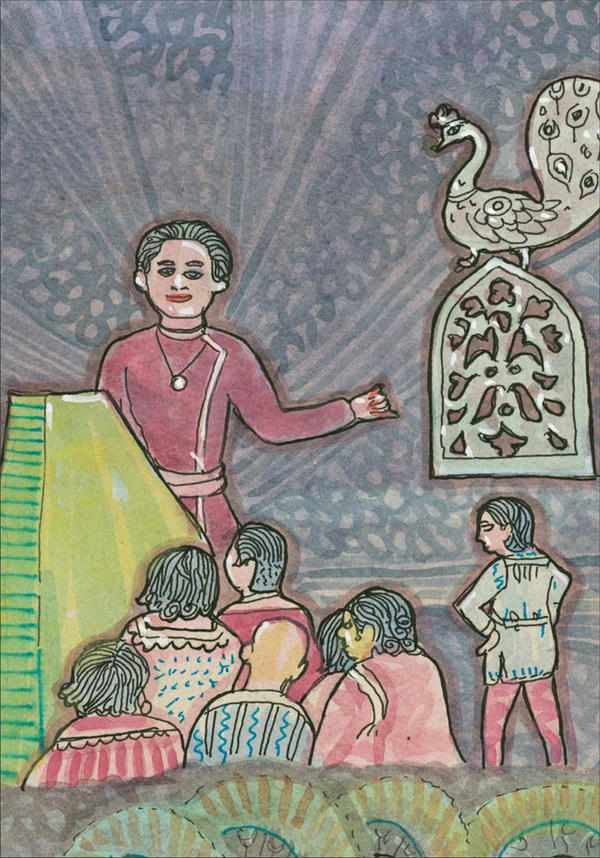
Every Sunday at his Sacramento Street temple, Sri Subramuniya gave discourses on yoga, the Self, states of mind and practical applications of Hindu mysticism. In a mostly Catholic city, he was among the first teachers of an Eastern path.
• • • • • • • • • • • • • • • • • • • • • • • •§
One day it was discovered that one of the monks had taken a few dollars from the day’s offerings. He had grown hungry, he confessed, due to the sparse meals they could afford, and he had purchased extra food for himself. It was, for Sri Subramuniya, a minor tragedy which he would reference thirty years later as unacceptable behavior. He scolded the monk, first alone, and then in front of the others, then required a severe penance to be performed. It was made clear to all the monks that even their own suffering was no excuse to break the bonds of trust. The order learned many such lessons and grew in strength and maturity.§
Some had difficulty obtaining the blessings or approval of their families to lead a renunciate life. A few families objected vehemently to their son’s joining a completely unheard of and seemingly exotic order. One father stood knocking on the door of the San Francisco monastery, insisting his son return home, calling him in a loud and desperate voice. In such cases, Sri Subramuniya sometimes sent the monk back to live with his family for a time. Others he would send on mission, “on the road,” to be alone and reflect on their commitments. One young man was instructed to join the armed services for two years to work through his karmas. §
There were women in the congregation who saw the spiritual progress of their counterparts and pleaded to also be taken into monastic life. There were three of them in the beginning, and through gentle persistence they convinced Sri Subramuniya of their deep devotion. In late 1960 he initiated them into monastic vows as the Sisters of Devotion. §
Like the monks, the nuns wore Western-style habits: austere, hooded brown robes with a white rope tied at the waist. They shaved their heads and looked much like the men, striving to be pure, spiritual beings, beyond gender, by balancing their feminine and masculine energies. Some mistook them for men. Their service revolved around the devotional services, the nurturing of families and their own spiritual disciplines. They lived apart from the monks and came to the temple each day for classes and service. These Sisters of Devotion—who cleaned and cooked, counseled the women, brewed tea for temple visitors, handled mailings and stocked the little bookshelf—brought a tangible sense of caring, which was called the Mother Spirit, to Sri Subramuniya’s mission. §
In 1961 the Church purchased a house in Glendale, a suburb of Los Angeles, dedicating it as the Glendale Monastery for the three Mother Nuns. Sri Subramuniya gave them the mission of service and silence.§
To strengthen the families, Sri Subramuniya wrote the Catechism of the Christian Yoga Church, outlining the fundamental principles of religious life and the philosophical and theological doctrines of the Church. He began regular home services and meditations to be observed mornings and evenings by the families in their shrine rooms. Seven Holy Weeks were designated—seven periods around the year of special sadhana and spiritual striving, fasting and reaffirmation of commitment to the inner path. Each Holy Week was dedicated to a great saint or important religious festival and corresponded to one of the seven chakras of the subtle body of man. These would become the annual focus of more intense spiritual work for all his followers.§
Following on his study of the American church system and numerous religious organizations in the US, Sri Subramuniya decided in late 1961 that he would file for official designation as a church from the Internal Revenue Service. On February 12, 1962, the IRS sent formal approval of his church’s tax exempt status. It was the first American church teaching Hinduism to be so acknowledged.§
The Church summarized its mission in a press release: “Father Subramuniya’s teachings have reached students in India, Ceylon, England, Germany, South America and even West Africa. He says, ‘Christian Yoga answers the questions “Who am I? Where did I come from? Where am I going?” Members of the church learn how to explore the depths of their inner being to find these answers through concentration and deep meditation.’”§
While his outer life was immersed in the founding of his mission and the training of his monks, Sri Subramuniya’s inner life grew even more intense and profound. It would prove a challenge to him, to balance the two. He had come to this Earth, he would later say, to do the inner work of realization, and equally he had been prepared from childhood to lead a spiritual renaissance, to bring the mystical truths to those ready for them. But those two aspirations, each enormous, did not always sit well with each other. §
There were times, he said, when he had to give a sermon on some mundane subject while his superconscious state of mind was soaring in another realm. To function in the outer world, he had to bring himself down to Earth, work hard to regain a “normal” perspective on life, so he could speak with others, guide them, inspire them. The reclusive, mystic yogi in him was, for a time at least, at odds with the founder of a spiritual institution. Through all that, he remained determined to make both of these goals work in his life. §
Mystics do not always have an easy time living in the world. Functioning sometimes is extremely difficult, because though apparently they become sensitive, they also become stronger in all of their various other senses. Sensitivity cannot in any way be equated with being weak. Mystics do, however, become very different than other people. §
In the early 1960s I went through a very difficult time functioning in the world because I was working intently with the unfoldment of a large number of students. Every time I picked up something that was heavier than a piece of paper, my arms and hands would turn to light, and instead of seeing the physical body, I would see the inner body. If I were to carry a book or a chair, first my hands would turn to light, then the light would creep up my arms and down my legs and the body would start fading away, invariably. This went on for about six years of my life. During this time, even a piece of paper was heavy. It was even difficult to wear a wristwatch because then that arm would turn to light. I would be more conscious of this beautiful light arm, that looked like crystal plastic, than I would be of other things. I would love to watch it, all scintillating in energy. It was just lovely. §
Even while driving a car, it was great fun because each time I pressed my hands hard on the steering wheel, my whole body would start turning to light and I would start to see the most dense areas of the car in front of me, which was just the chassis part. All the top part and the people would fade away. I would only see the heaviest types of metal. §
A mystic can really live in a wonderful world, if he prefers. Now I can be in this state if I want to. It is voluntary. It’s not an involuntary state anymore. I remember once while in that state, I had to put the garbage can out on the sidewalk, and there was no one to carry it. I had a terrible time. I would get the can just so far and turn all to light and have to put it down again. Finally, with great effort, I got it out. It seemed like a long way. During this time, if the phone rang, it sounded so loud, and it was just a terrific thing to pull the physical elements together again so that I could answer it. §
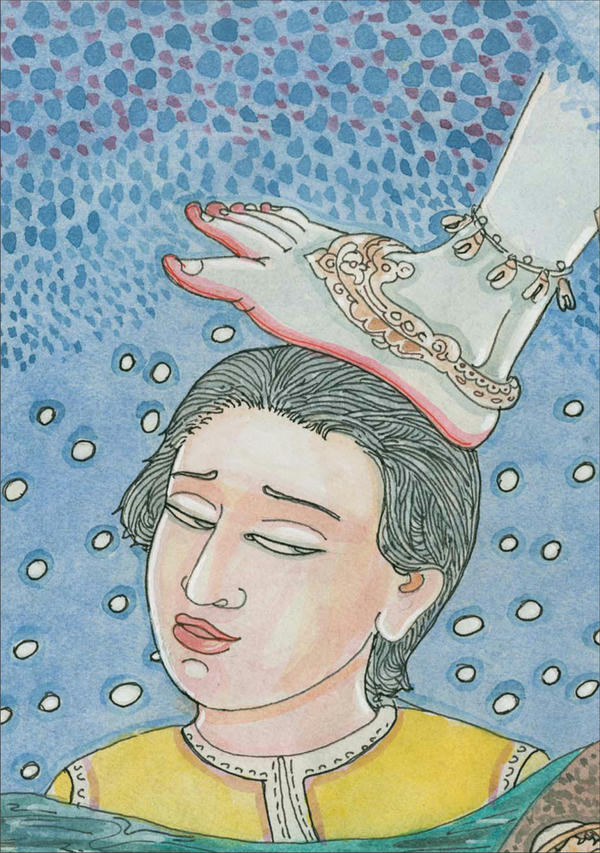
In the late 1950s, as he was establishing his spiritual mission, Sri Subramuniya had a vision of Siva dancing on his head. He could hear the accompanying musical instruments and in that same moment saw two unusual doors opening, doors he would discover were the entrance to his future temple.
• • • • • • • • • • • • • • • • • • • • • • • •§
Mark Twain’s Favorite Brewery
Following a 1962 summer retreat at Angora Lake, Sri Subramuniya visited nearby Virginia City, Nevada, to find a piece of property that could serve as a permanent retreat center. He didn’t have to look far. About a quarter mile down the canyon from this legendary boom town of the Old West, he found a large, ramshackle brewery, originally built in 1864 on the site of the famed Comstock Lode Gold Rush. It was for sale. §
Its austere Sierra Nevada mountain terrain, with its sagebrush and piñon pine landscape, something that might intimidate others, was appealing to him. It was yogic, almost desolate. It was a place where the inner was more important than the outer. His first thought, when he stepped inside, was, “What a wonderful ashram this would make!’’ He wandered through its cavernous rooms, on three floors, and, despite the dilapidated condition of the landmark, he arranged to purchase it.§
The building, known as the Old Nevada Brewery, was the favorite haunt of American humorist Mark Twain. Samuel Clemens (Twain’s real name) was first a writer and then the editor of the Territorial Enterprise in Virginia City from 1862 to 1864, a time during which he wrote his famed novel Roughing It. Each afternoon, it is said, he took refuge in the beer gardens of this biggest and most popular pub, telling tall tales to rowdy miners. And there were large crowds. In those days, Virginia City, with 30,000 people, was nearly half as populous as San Francisco, due to the gold rush which brought people from all over the world to the Wild West to dig into the sage-covered hills.§
The landmark had been a silent memorial for half a century when Sri Subramuniya, the new owner, stepped into its brick and fancy-woodwork rooms. Its age was showing. The resident caretaker was a grizzled old prospector who kept his mule in the basement and a pig in the shower. He was hard of hearing and required more than a little convincing that his residence had indeed changed owners. §
Church families adopted the ashram at once, like parents embracing an orphaned child, pouring their hearts and souls, and their money, into it the rest of that summer to bring it up to Sri Subramuniya’s standards. Several monastics stayed as caretakers through the snow-throttled Nevada mountain winter, and plans for major renovations were made for the spring. The ashram became the Skandamalai Monastery (also called the Mountain Desert Monastery), reflecting Sri Subramuniya’s insight that Murugan, Skanda, is the lord of renunciates, who would be its residents. §
It would also be home of Comstock House, a major publication and printing facility, and the new center for the burgeoning Himalayan Academy courses and programs. For years, at this remote and desolate mountain aerie, 6,500 feet above sea level, Sri Subramuniya would train his renunciates and issue forth the teachings of Vedanta, Siddhanta and the Saivite religion through literature, travel programs, seminars and courses. §
The Chemical Chaos of LSD
American television and magazines showed the world the first hippies and flower children in 1964, as the psychedelic movement and drug era reached its stride. Its Mecca was a tiny, previously unremarkable neighborhood in San Francisco called Haight-Ashbury, just over a mile from the Sacramento Street temple. Because of the nationwide news coverage given to the hippie movement and this district, young people from across the US began pouring into the area. §
It was a curious feature of the birth of the drug era in America that no one quite took it seriously until it was almost too late. When Sri Subramuniya saw the number of youths arriving in the city and the continuing national news coverage, he arranged a meeting between the mayor’s staff and representatives of the various religions and social workers who were ministering to the problem. As a result, the San Francisco Chronicle carried a series of stern articles by the mayor and others warning young people intending to migrate to the city for the drug culture to stay away. §
In the early years of the hippie movement, no one in America knew quite what to make of it. Sri Subramuniya was well aware of its inner implications and dangers and spoke out against it, but even he had not foreseen how it would mushroom out of control across the country. §
The first time that I learned of LSD, shortly after it was discovered [by recreational users], I went to the Menlo Park Clinic to find out something about it. I talked with one of the psychiatrists there and he began explaining these different experiences one might have on this drug. I said to him, “Some of these experiences you describe—spiritual revelations, expanded awareness, blissful and brilliant inner experiences—are the ones I have had every day of my life for the last twenty years through the faculty of meditation.” He responded, “Well, my, you are fortunate, aren’t you?”§
The crisis had its influence on the Church. As the year progressed, the number of odd-looking visitors to classes and services increased. For several years the American guru would counsel thousands of LSD users. His primary point was not that drugs are wrong, but that there is a better way, an ancient, natural and proven way, to achieve mystical experiences. §
Gently, he encouraged young men and women to abstain from all drugs and, instead, to undertake the disciplines of yoga. The trouble with drugs, he told them, was that even if drugs stimulate such experiences, they provide no foundation or understanding of them, no way to repeat the experience or benefit from it. Nothing is gained for the damage done to the nerve system and mind. His words were never accusatory, and they had special power, for he knew personally the profound states of mind they had experienced and told him of. He had been there, they could see, so they trusted his counsel.§
Sri Subramuniya’s meditations on this social upheaval, whose epicenter was in his city, led to a talk in the temple called “Chemical Chaos,’’ an exposition and criticism of the psychedelic movement and its philosophy. He directed the monks and adult counselors to do what they could to relieve the human suffering caused by the use of drugs, and he helped a great deal to spread an understanding of the nature of the problem among the city’s ministers and others. §
In the early 60s I became conscious that more and more of the people who came to me for counseling wanted to talk over aspects of their experience in higher states of the mind, states of the mind that had been opened through psychedelic experience. Their interest was in relating these experiences to yoga and the consciousness attained through meditation. These people were highly enthusiastic about their new world, for it seemed like sort of a canned meditation, something they could get very quickly without entering into the sometimes tedious yoga training that may take years to open the individual to the within of himself. People all over the nation now are becoming awakened to the world within.§
I have interviewed seekers who have had a few psychedelic experiences and have come through them more vibrant, more alive, and more ready to face the challenges of a new world. I have met others who only stand and look at you blankly, who have lost their desire, even their self-respect. They have lost, shall we say, the structure through which their mind force previously flowed, and it has not been replaced.§
I don’t want to see a nationwide or worldwide movement built around a little bit of “acid.” I don’t want to see this, because of the young souls for whom this would be devastating. Some young souls who have been opened up without preparation stumble into psychic ability. They may read thought forms, see auras or travel astrally. In yoga we would say that this path of psychism must be avoided until you have attained Self Realization. This is because in opening up the mind to higher forces and beautiful experiences, we also open ourselves up to the unpleasant experiences of the shadow world of the chakras below the muladhara center at the base of the spine, areas of consciousness which we cannot control without preparation and training. §
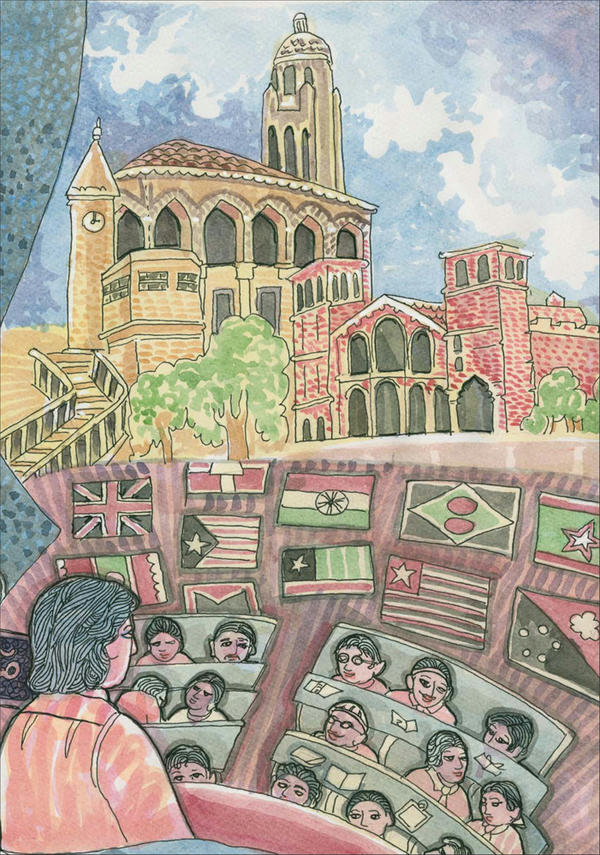
In the 60s and 70s, America’s time of foment, drug experimentation and spiritual questing, Sri Subramuniya undertook a series of lectures at major universities in America and Europe, teaching the advaita path to all who would listen.
• • • • • • • • • • • • • • • • • • • • • • • •§
In yoga, the guru knows how to protect his students in the opening-up process by closing off the lower realms as the higher ones open. He knows how to do this, but it is a steady training and does require time. I have met people who have had the psychedelic experience who cannot walk down the street past certain houses because they have become so sensitive to the contention, the negative force field, emitted from a certain home. Some of these people are opened up to the more subtle forces of the lower mind.§
I believe that the gap which has been created between “turned on people” and “turned off people” can best be bridged through meditation, gaining control of the mind so that the individual can become master of himself. When you become master of yourself, you truly stand alone in completeness, not in loneliness. In doing so, you are able to bring forth knowledge and wisdom from yourself through the process of meditation, through being able to sit down and think through a problem, ultimately seeing it in full, superconscious perspective and bring forth an answer, a workable answer filled with life. Meditation is a dynamic process. It is much more than just sitting around and waiting. It creates a highly individualistic type of mind.§
In early 1967 he arranged to meet with Dr. Richard Alpert, who, along with Dr. Timothy Leary, had become a kind of LSD evangelist, urging American youth to “Tune in, turn on and drop out.” The meeting was arranged by a young monk, who accompanied Sri Subramuniya. Over a spaghetti dinner in a Berkeley apartment, they discussed the illuminating and sometimes devastating states of mind provoked by LSD. §
Sri Subramuniya told him that the higher planes were open to souls who reached them through normal means, but when unqualified people began to show up astrally using drugs, the devas closed all doors. Sri Subramuniya alerted him to stop what he and Timothy Leary were doing, right away. Any souls using drugs would be caught in the lower astral plane, unable to expand their consciousness. §
The errant former Harvard professor, who had taken LSD hundreds of times, leaned forward and listened most intently when, toward evening’s end, Sri Subramuniya gave stern warnings of the karmas he was creating by putting all these young lives at risk. Alpert was entreated, firmly, to desist; and though he did not say he would, that conversation may well have led to his life-transforming journey to India—where he became a devotee of Neem Karoli Baba, who gave him the name Ram Dass—and his change of mind soon thereafter, when he publicly spoke against LSD.§
Also in 1967, the founder of ISKCON, Vaishnava guru Swami Prabhupada, took up residence in San Francisco, establishing a small Krishna temple on Frederick Street, on the edge of the Haight-Ashbury district. Sri Subramuniya, as he always did, visited, welcoming the spiritual master from India and offering help getting established in the West. Members regularly took boxes of fruits and grains to help feed Swami Prabhupada’s followers. He would regale Sri Subramuniya’s followers with long stories from scripture, and he once visited the Sacramento Street Temple, giving a short upadesha and leading bhajan. §
In other ways through the years, Sri Subramuniya assisted Hindu leaders seeking to establish themselves in America, such as loaning his attorney to Swami Chinmayananda when he needed help incorporating the Chinmaya Mission in the US.§
Taking Charge
Through the 1950s and early 60s, Mother Christney played a significant role in the Church. At the Sacramento Street temple she served as head of the order of nuns and, as an elder, stood strongly behind Sri Subramuniya. One devotee recalls his own early days in the congregation: §
Mother Christney was then 83 years old. During Sunday Church activities, she attended by sitting in a little room behind the altar while Sri Subramuniya gave his sermons. At times she would lecture me and other newcomers about her life and times. She always supported Sri Subramuniya with such sayings as, “Obey your guru, obey your guru, obey your guru,” and “Your guru will show you the way to your spiritual destiny.” §
At the same time, Mother Christney remained a bastion of Christian influence. As she grew more senior in years, and he came into his full authority as a Hindu guru, she attempted to make administrative changes in the Church. Her efforts failed; and in 1967, with the onset of senility, she left the congregation, retiring to live with her son. Sri Subramuniya, now solely responsible, set about removing all vestiges of her mystical Christianity from the order’s teachings and redefining his organization as fully Hindu.§